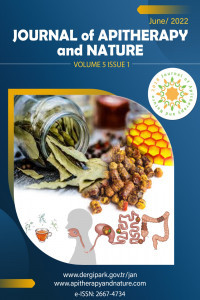Defne Yaprağından (Laurus Nobilis L.) Fenolik Bileşiklerin Ekstraksiyonunda Farklı Yöntemlerin Karşılaştırılması
Bu çalışmada, mikrodalga destekli ve enzim destekli ekstraksiyon verimliliği çözgen ekstraksiyonu ile karşılaştırılmıştır. Defne yaprağı ekstraktında ekstraksiyon verimleri fenolik içerik ve antioksidan kapasitesi açısından değerlendirilmiştir. Geleneksel ekstraksiyon, enzim destekli ve mikrodalga destekli ekstraksiyon olarak üç farklı ekstraksiyon yönteminden elde edilen ekstraktların toplam fenolik içeriği (mg GAE/g) sırasıyla 23.29±0.02, 32.45±0.02 ve 30.49±0.02 olarak bulunmuştur. Toplam fenolik içerik için en yüksek değer enzim destekli ekstraksiyonda belirlenmiştir. Üç farklı ekstraksiyon yönteminden elde edilen ekstraktların DPPH radikal süpürme aktivitesi (%) sırasıyla %36.91±0.05, %50.72±0.27 ve %41.51±0.09 olarak bulunmuştur. Toplam fenolik içerik gibi, DPPH radikal süpürme aktivitesi için en yüksek değer enzim destekli ekstraksiyonda belirlenmiştir. Ayrıca defne yaprağının toplam kuru madde, toplam kül, toplam protein, askorbik asit ve toplam klorofil içeriği belirlenmiştir.
Anahtar Kelimeler:
enzim destekli ekstraksiyon, mikrodalga destekli ekstraksiyon, defne yaprağı, fenolik bileşikler
Comparison of Different Methods in the Extraction of Phenolic Compounds from Bay Leaf (Laurus nobilis L.)
In this study, the microwave-assisted and enzyme-assisted extraction efficiency were compared to solvent extraction. The extraction efficiencies were evaluated in bay leaf extract in terms of phenolic content and antioxidant capacity. The total phenolic content (mg GAE/g) of the extracts from three different extraction methods as a solvent, enzyme-assisted, and microwave-assisted extraction was found 23.29±0.02, 32.45±0.02, and 30.49±0.02, respectively. The highest value for the total phenolic content was found from the enzyme-assisted extraction. DPPH radical scavenging capacity (%) of the extracts from three different extraction methods was found at 36.91%±0.05, 50.72%±0.27, and 41.51%±0.09, respectively. Like the total phenolic content, the highest value for the DPPH radical scavenging capacity was found from the enzyme-assisted extraction. In addition, total dry matter, total ash, total protein, ascorbic acid, and total chlorophyll content of the bay leaf were analyzed.
___
- AOAC. (1990). Official method of analysis (14th ed.). Association of Official Analytical Chemists, Washington, DC, USA.
- Anticona, M., Blesa, J., Frigola, A., & Esteve, M. J. (2020). High biological value compounds extraction from citrus waste with non-conventional methods. Foods, 9(6), 811.
- Bajaj, K.L., & Kaur, G. (1981). Spectrophotometric determination of L-ascorbic acid in vegetables and fruits. Analyst, 106(1258), 117-120.
- Bilek, S.E. (2010). The effects of time, temperature, solvent: solid ratio and solvent composition on extraction of total phenolic compound from dried olive (Olea europaea L.) leaves. The Journal of Food, 35, 411-416.
- Boulila, A., Hassen, I., Haouari, L., Mejri, F., Amor, I.B., Casabianca, H., & Hosni, K. (2015). Enzyme-assisted extraction of bioactive compounds from bay leaves (Laurus nobilis L.). Industrial Crops and Products, 74(2015), 485-493.
- Chakraborty, S., Uppaluri, R., & Das, C. (2020). Optimization of ultrasound-assisted extraction (UAE) process for the recovery of bioactive compounds from bitter gourd using response surface methodology (RSM). Food and Bioproducts Processing, 120, 114-122.
- Gan, Y., Xu, D., Zhang, J., Wang, Z., Wang, S., Guo, H., Zhang, K., Li, Y., & Wang, Y. (2020). Rana chensinensis ovum oil based on CO2 supercritical fluid extraction: Response surface methodology optimization and unsaturated fatty acid ingredient analysis. Molecules, 25(18), 4170.
- Garcia, E. J., Oldoni, T. L. C., Alencar, S. M., Reis, A., Loguercio, A. D., & Grande R. H. M. (2012). Antioxidant activity by DPPH assay of potential solutions to be applied on bleached teeth. Brazilian Dental Journal, 23(1), 22-27.
- Li, H. Bin, Wong, C. C., Cheng, K. W., & Chen, F. (2008). Antioxidant properties in vitro and total phenolic contents in methanol extracts from medicinal plants. LWT-Food Science and Technology, 41(3), 385–390.
- Mandal, V., Mohan, Y., & Hemalatha, S. (2007). Microwave assisted extraction-an innovative and promising extraction tool for medicinal plant research. Pharmacognosy Reviews, 1(1), 7-18.
- Molina-Alcaide, E., & Yáñez-Ruiz, D. R. (2008). Potential use of olive by-products in ruminant feeding: A review. Animal Feed Science and Technology, 147(1-3), 247-264.
- Muñiz-Márquez, D. B., Wong-Paz, J. E., Contreras-Esquivel, J. C., Rodríguez-Herrera, R., & Aguilar, C. N. (2018). Bioactive compounds from bay leaves (Laurus nobilis) extracted by microwave technology. Zeitschrift Fur Naturforschung-Section C Journal of Biosciences, 73(9–10), 401–407.
- Özkan, G., & Bilek, S. E. (2015) Enzyme-assisted extraction of stabilized chloropyll from spinach. Food Chemistry, 176, 152-157.
- Pai, S., Hebbar, A., & Selvaraj, S. (2022). A critical look at challenges and future scopes of bioactive compounds and their incorporations in the food, energy, and pharmaceutical sector. Environmental Science and Pollution Research, 1-24.
- Sayyah, M., Saroukhani, G., Peirovi, A., & Kamalinejad, M. (2003). Analgesic and anti-inflammatory activity of the leaf essential oil of Laurus nobilis Linn. Phytotherapy Research, 17(7), 733-736.
- Simić, M., Kundaković, T., & Kovačević, N. (2003). Preliminary assay on the antioxidative activity of Laurus nobilis extracts. Fitoterapia, 74(6), 613–616.
- Tainter, R. D., & Grenis, A. T. (1993). Spices and seasonings. Food Technology Handbook, VCH Publishers Inc., New York, 104–112.
- United States Department of Agriculture (USDA), (1997). Spices, bay leaf. FoodData Central Search Results, SR LEGACY, 170917. Retrieved 2022 from https://fdc.nal.usda.gov/fdc-app.html#/food-details/170917/nutrients.
- Vernon, L. P. (1960). Spectrophotometric determination of chlorophylls and pheophytins in plant extracts. Analytical Chemistry, 32(9), 1144-1150.
- Yağcıoğlu, P. (2015). Farklı ekstraksiyon metotları ile adaçayı (Salvia officinalis L.) bitkisinden antioksidan ekstraksiyonunun optimizasyonu (Doctoral dissertation). Available from Council of Higher Education and Theses database. (Thesis No. 421022).
- Zhang, H., Birch, J., Ma, Z. F., Xie, C., Yang, H., Bekhit, A. E. D., & Dias, G. (2019). Optimization of microwave-assisted extraction of bioactive compounds from New Zealand and Chinese Asparagus officinalis L. roots. Journal of Food Science and Technology, 56(2), 799-810.
- Zulkafli, Z. D., Wang, H., Miyashita, F., Utsumi, N., & Tamura, K. (2014). Cosolvent-modified supercritical carbon dioxide extraction of phenolic compounds from bamboo leaves (Sasa palmata). The Journal of Supercritical Fluids, 94, 123-129.
- Yayın Aralığı: Yılda 2 Sayı
- Başlangıç: 2018
- Yayıncı: Oktay YILDIZ
